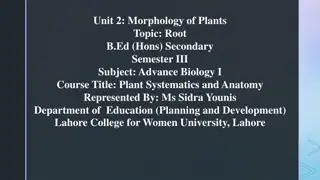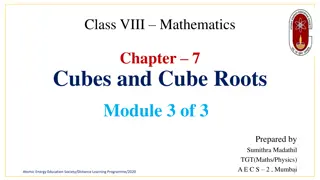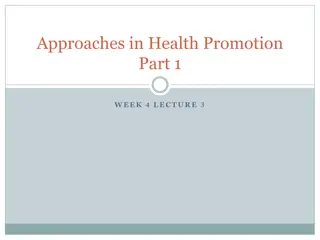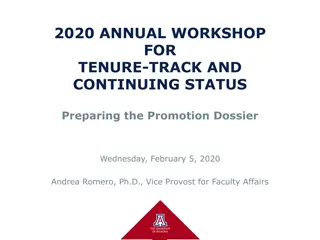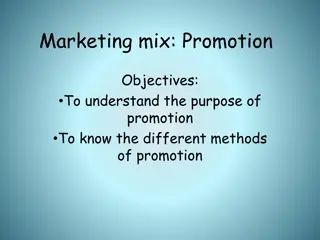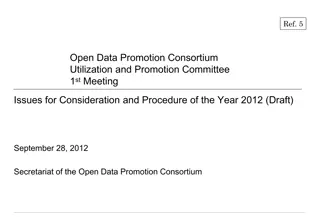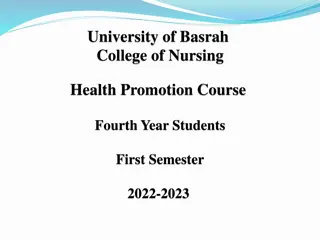Understanding the Roots and Scope of Health Promotion Models
Health promotion has evolved from early health education movements to encompass a broader approach focusing on enabling individuals and communities to improve their health. Various frameworks and models such as Beattie's model emphasize different strategies like legislative action, community development, and health persuasion to address health promotion effectively.
Download Presentation

Please find below an Image/Link to download the presentation.
The content on the website is provided AS IS for your information and personal use only. It may not be sold, licensed, or shared on other websites without obtaining consent from the author. Download presentation by click this link. If you encounter any issues during the download, it is possible that the publisher has removed the file from their server.
E N D
Presentation Transcript
Session outcomes 1. The explain the roots of health promotion 2. To apply three different frameworks(models or typologies) that explain the scope of health promotion to different contemporary topics 3. To explain selected principles of health promotion practice in relation to a case study
The roots of health promotion Health Promotion emerged from health education movement. Health education noticeable in early 1900s with emphasis on cleanliness, personal behaviour and therefore responsibility for one s own ill-health and health. The Central Council for Health Education was founded in 1927.
What is Health Promotion? Today Health Promotion is more than personal and population education. Defined in a number of ways The process of enabling people to increase control over and improve their health (World Health Organization 1986) Health Promotion = health education x healthy public policy (Tones and Tilford, 1994)
The scope of health promotion activity Frameworks and Models are tools that help explain phenomena. Many tools developed to explain the scope of health promotion. Tannahill (1985) model of health promotion Naidoo and Wills (2000) typology of health promotion Beattie (1991) model of health promotion Tones and Tilford (1994) empowerment model of health promotion Caplan and Holland (1990) Four perspectives on health promotion
Beatties model of Health Promotion Authoritative Legislative Action Focus Act Resources Policy Health persuasion Needs to focus on why behaviour is happening Individual Collective Community Development Empowerment community level Skills Personal Counselling Greater control Negotiated
Beatties model applied Key features Examines 2 axes: i) type of approach used: top down (authoritarian) or bottom up (negotiated or owned by clients) ii) size of approach Categorizes 4 types of activities: a) Personal Counselling, e.g. working with dietician on food and physical individual personal plans and goals. b) Health persuasion, e.g. campaign of eating 5 fruit and vegetables a day on TV. c) Legislative action, e.g. laws that subsidize the price of healthy food stuffs. d) Community development, e.g. communities producing and distributing food themselves.
Lobbying, Advocacy & mediation Coalitions Healthy Public Policy Public Pressure Social, Economic and Environmental Influences Reframe & reorient health services HEALTH Community Empowerment Individual empowerment Critical consciousness raising A. S. HEALTH EDUCATION An Empowerment Model (adapted from Tones & Tilford 2001)
Tones and Tilfords (1994) model of health promotion Key features Interaction between two main sets of processes for health improvement: i) development and implementation of healthy public policy; ii) health education in which people are empowered to take control of their life. Example is attempts of Jamie s School Dinners campaign where school meals were brought into public consciousness and led to standards for meals and an increase in the budgets for school meals. Only when these two approaches work in parallel can the conditions for living and individuals behavioural aspects of health be addressed.
Caplan and Hollands model of health promotion (1990) Radical change Nature of society Radical Humanist Radical structuralist Subjective Objective Nature of knowledge Traditional Humanist Social regulation
Caplan and Hollands model of health promotion (1990) Key features More complex and theoretically driven. Attempts to unpick what determines health and ill- health and therefore what activities can be used to address health issues. One axis refers to a theory of knowledge and how knowledge is generated in relation to health. The other axis refers to how society is constructed and how this impacts on health.
Application to domestic violence Nature of society Radical Humanist Provide supportive networks and self-help groups and use of safe houses to remove women from violence. Women to gain more power by developing economic and social power via work and stronger networks. Radical structuralist Working to reduce power inequality between men and women through legislation for gender equality. Issue to be taken seriously by criminal justice system. Social unacceptability of issue generated through advocacy and lobbying. Nature of knowledge Humanist Working with women (and men) directly so they can understand the nature of their experiences and what they can do themselves. Using cognitive- behavioural therapy (CBT) approaches to understand the issues and change behaviour. Traditional Treatment of injuries. Educational campaigns about the issue to raise awareness and change attitudes to domestic violence in populations.
Key principles in health promotion Principles are important as they relate to how we should work in practice The World Health Organization provides a global perspective Gregg and O Hara (2007) provide a good synthesis of many of these
Focus on upstream approaches You know , he said, ...sometimes it feels like this. There I am standing by the shore of a swiftly flowing river and I hear the cry of a drowning man. So I jump into the river, put my arms around him, pull him to shore and apply artificial respiration. Just when he begins to breathe, there is another cry for help. So I jump into the river, reach him, pull him to shore, apply artificial respiration, and then just as he begins to breathe, another cry for help. So back in the river again, reaching, pulling, applying, breathing and then another yell. Again and again, without end, goes the sequence. You know, I am so busy jumping in, pulling them to shore, applying artificial respiration, that I have no time to see who the hell is upstream pushing them all in. (McKinlay, 1979 p. 249)
Non-victim-blaming approaches Victim-blaming is an approach to health education which only focuses on individual action rather than the external forces that influence an individual person, resulting in blaming people for their health behaviour and related consequences (Hubley et al., 2020). Practitioners should resist victim-blaming as it does not show understanding of the influences of health behaviour. Instead, practitioners should consider the social and economic experiences of people s lives which may explain how and why people behave in the manner that they do.
Evidence-based practice Evidence-based practice is concerned with trying to understand which approaches and methods of working are likely to produce the strongest health improvement. Generating evidence by providing stronger evaluation of programmes and initiatives as they are developed and implemented, and encouraging the utilization of the existing evidence base by practitioners, are both key principles of practice.
Participation and empowerment Participation implies being present and taking part in health promotion activities and, secondly, recognizing that, when people participate, what they say should be listened to and acted upon (Lowcock and Cross, 2011) Empowerment is an approach that facilitates people working together to increase the control that they have over events that influence their lives and health (Woodall et al. 2010) Given that a definition of health promotion is about taking control, then these two interlinked concepts are fundamental to how we act as practitioners
Equity Equity in health is concerned with fairness and the idea that everyone should have an equal right to the fullest health possible. The term inequity enshrines an unfair distribution of health status, e.g. poorer health is experienced in lower social classes. Health should be more equally distributed and health promotion approaches should, as a high priority, address health inequities. Policies and projects are now being evaluated to assess their impact on health equity, to reduce the disproportional impact on those that already experience poorer health, using a technique known as health equity audits (Office of the Deputy Prime Minister and Department of Health, 2005).
Ethical principles There are four major ethical principles outlined in Naidoo and Wills (2016): Autonomy Respect for the rights of individuals and their rights to govern their own lives (Naidoo and Wills, 2016 p. 96) Beneficence Doing and promoting good but we would need to consider whose good, the individual or wider group Non-maleficence Doing no harm Justice People should be treated equally and fairly
Summary The scope of health promotion is varied and diverse and not limited to health education. In order to address health issues, a wider range of health promotion approaches should be used that directly addresses the wider upstream determinants. Approaches should be evaluated on the basis of key health promotion principles.








